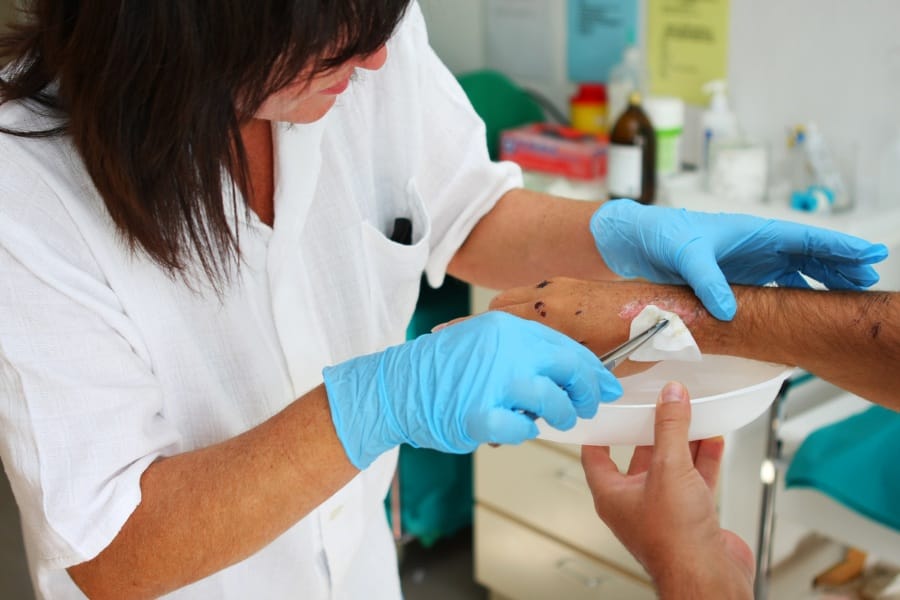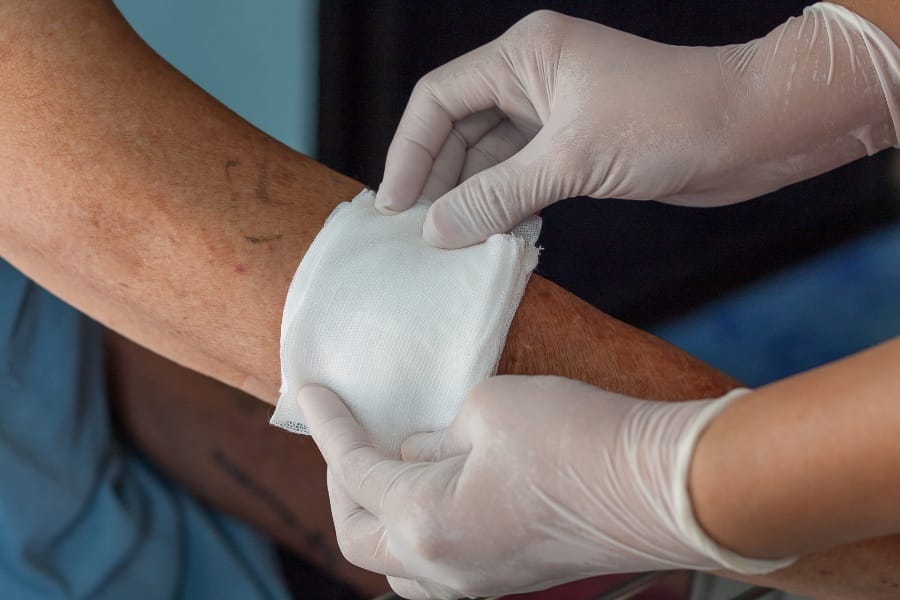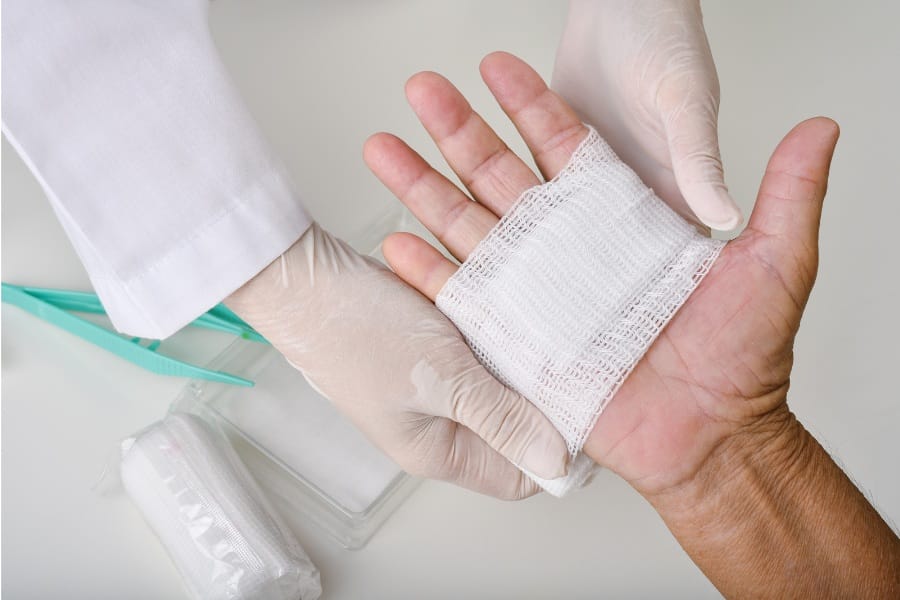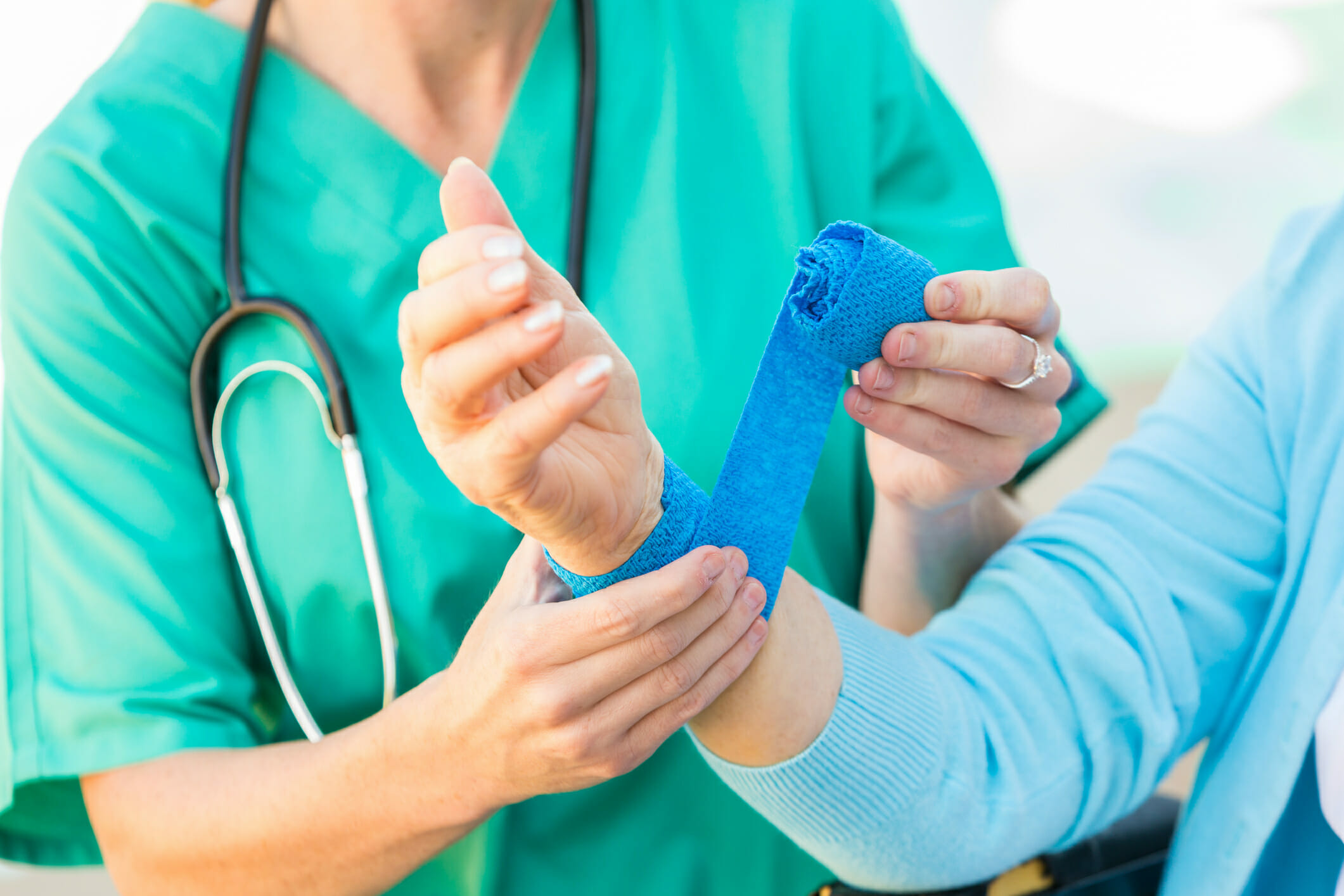Currently, there are over 40 million inpatient and 31 million outpatient surgeries performed annually in the US.
Despite advancements in technology and best practices, infections at the surgical site continue to be the second most common issue affecting hospitalized patients, affecting about 1.4 million people per year.
A surgical site infection (SSI) has been proven to double the patient’s risk of death from 3.5% to 7.8%, increase the likelihood of an ICU stay, lengthen hospital stays, and increase the probability of readmission from 7% to 41 percent.
What are Surgical Site Infections?
IN THIS ARTICLE

Surgical site infections (SSIs) are infections that occur after surgery in the part of the body where the surgery took place.
These infections can be caused by bacteria that enter the body during surgery or by bacteria that are already present on the patient’s skin.
Types and Prevalence of SSIs
SSIs can be classified into three types, depending on the time of onset:
- Superficial incisional SSI: infection occurs within 30 days of the operation and involves only the skin and subcutaneous tissue.
- Deep incisional SSI: infection occurs within 30 days of the operation and involves deep soft tissues (e.g., fascia and muscle) of the incision.
- Organ/space SSI: infection occurs within 30 days of the operation and involves any part of the body other than the incision, such as organs or spaces.
SSIs are the most common type of healthcare-associated infection (HAI) and account for approximately 20% of all HAIs.
The prevalence of SSIs varies depending on the type of surgery and the patient population.
For example, SSIs are more common in patients who are older, have underlying medical conditions, or have a weakened immune system.
Risk Factors for SSIs
Several risk factors can increase the likelihood of developing an SSI, including:
- Patient-related factors: such as age, obesity, smoking, diabetes, and immunosuppression.
- Surgical factors: such as the length of surgery, the type of surgery, and the number of people involved in the surgery.
- Environmental factors: such as the cleanliness of the operating room and the sterilization of equipment.
Nurses play a critical role in preventing SSIs by implementing evidence-based practices and monitoring patients for signs of infection.
By understanding the types and prevalence of SSIs and the risk factors associated with them, nurses can take proactive steps to prevent these infections and improve patient outcomes.
Preoperative Strategies to Prevent SSIs

Preoperative strategies play a crucial role in preventing surgical site infections (SSIs).
Nurses can take several measures to minimize the risk of SSIs and ensure a safe surgical experience for their patients.
Patient Education and Preparation
Patient education and preparation are essential components of preoperative care.
Nurses can educate patients on the importance of maintaining good hygiene, such as taking a shower with an antiseptic soap before surgery.
Patients should also be advised to avoid shaving the surgical site, as this can increase the risk of infection. Instead, patients should be instructed to trim their hair with scissors.
In addition to educating patients, nurses should ensure that patients are adequately prepared for surgery.
This includes obtaining a thorough medical history and conducting a physical examination to identify any risk factors for SSIs. Nurses should also ensure that patients receive appropriate antibiotic prophylaxis before surgery.
Antibiotic Prophylaxis and Skin Antisepsis
Antibiotic prophylaxis and skin antisepsis are critical strategies for preventing SSIs.
Nurses should work with the surgical team to ensure that patients receive appropriate antibiotic prophylaxis before surgery.
This may involve administering antibiotics intravenously or orally, depending on the type of surgery.
Skin antisepsis is another critical component of SSI prevention. Nurses should ensure that patients receive preoperative skin antisepsis, which involves cleaning the surgical site with an antiseptic solution.
This can help reduce the number of bacteria on the skin and minimize the risk of infection.
Intraoperative Infection Control Techniques
Intraoperative infection control techniques are essential to prevent post-operative infections.
Nurses play a critical role in implementing these techniques to ensure that patients remain safe during surgery.
The following are some of the key techniques that nurses can use to prevent infections during surgery.
Aseptic Technique and Sterile Field Maintenance
Aseptic technique and sterile field maintenance are crucial to prevent infections during surgery.
Nurses must ensure that the surgical area is clean and sterile before the operation begins. They must also maintain the sterility of the field throughout the procedure.
This involves using sterile drapes, gowns, and gloves, as well as ensuring that all instruments used during the surgery are sterile.
Hand Hygiene and Use of Sterile Gloves
Hand hygiene is critical to prevent the spread of infection during surgery. Nurses must wash their hands thoroughly before and after the procedure.
They should also use antiseptic solutions to clean their hands and wear sterile gloves to prevent contamination of the surgical field.
Nurses must also be aware of the proper technique for donning and removing sterile gloves.
They should avoid touching non-sterile surfaces and use the appropriate technique to remove gloves without contaminating their hands.
Nurses must be knowledgeable and confident in implementing these techniques to ensure that patients remain safe during surgery.
By following the proper surgical procedures for aseptic technique, sterile field maintenance, hand hygiene, and use of sterile gloves, nurses can help prevent infections and promote patient safety.
Postoperative Wound Infection and Care Monitoring

Wound Care and Dressing Protocols
Postoperative surgical wound care is crucial to prevent infections and promote healing. Nurses play a significant role in ensuring that patients receive appropriate wound care.
Proper wound care involves an aseptic technique, which includes hand hygiene, using sterile gloves, and maintaining a clean environment.
Nurses should also monitor the wound site for signs of infection, such as redness, swelling, warmth, and drainage.
They should also assess the patient’s pain level and administer pain medication as needed. Dressings should be changed according to facility protocols or as ordered by the physician.
Documentation and Patient Monitoring
Documentation is an essential aspect of postoperative care. Nurses should document wound assessments, dressing changes, and any signs of infection.
This information should be communicated to the physician and other members of the healthcare team.
Patient monitoring is also crucial in preventing postoperative infections. Nurses should monitor vital signs, fluid intake and output, and assess for signs of sepsis.
They should also educate patients on the signs and symptoms of infection and encourage them to report any concerns.
Role of Healthcare Professionals in SSI Prevention
Nurses’ Responsibilities and Education
Nurses play a critical role in preventing post-operative infections. They are responsible for ensuring that patients receive appropriate care before, during, and after surgery.
They must also be knowledgeable about the latest infection control practices and guidelines.
Nurses should receive ongoing education on infection prevention, including hand hygiene, sterile technique, and appropriate use of personal protective equipment.
They should also be trained to identify and report any signs of infection, such as fever, redness, or drainage at the surgical site.
In addition, nurses should work closely with other healthcare professionals to ensure that all aspects of infection prevention are addressed.
This includes collaborating with surgeons, anesthesiologists, and environmental services staff to ensure that the operating room is clean and free from contamination.
Infection Prevention Guidelines and Protocols
Infection prevention guidelines and protocols provide a framework for healthcare professionals to follow in order to prevent infections.
Nurses should be familiar with these guidelines and protocols and ensure that they are followed at all times.
For example, the Centers for Disease Control and Prevention (CDC) recommends that all surgical patients receive an antibiotic within one hour prior to surgery. Nurses should ensure that this protocol is followed and that the correct antibiotic is administered.
Nurses should also ensure that all surgical instruments are properly sterilized and that the surgical site is properly prepped and draped. They should monitor patients closely for signs of infection and report any concerns to the healthcare team.
Get Exceptional Post-Op Care Today
Frequently Asked Questions about Post-Op Care
What are effective nursing interventions to prevent infection following surgery?
Effective nursing interventions to prevent infection following surgery include:
- Administering prophylactic antibiotics before surgery
- Maintaining proper hand hygiene before and after contact with the patient or the patient’s environment
- Encouraging the patient to cough and deep breathe to prevent atelectasis
- Ensuring that the patient’s incision site is clean and dry
- Monitoring the patient’s vital signs to detect signs of infection
- Encouraging the patient to ambulate as soon as possible to prevent blood clots
What role do nurses play in the prevention of surgical site infections?
Nurses play a critical role in preventing surgical site infections. They are responsible for:
- Administering prophylactic antibiotics before surgery
- Ensuring that the patient’s skin is properly prepped before surgery
- Maintaining proper hand hygiene before and after contact with the patient or the patient’s environment
- Monitoring the patient’s vital signs to detect signs of infection
- Educating the patient on how to care for their incision site after surgery
What preoperative practices can nurses employ to minimize the risk of post-op infections?
Nurses can employ several preoperative practices to minimize the risk of post-op infections, including:
- Administering prophylactic antibiotics before surgery
- Ensuring that the patient’s skin is properly prepped before surgery
- Educating the patient on how to prepare for surgery, such as showering with an antiseptic soap
- Assessing the patient for any underlying medical conditions that may increase their risk of infection
How can nurses educate patients on preventing wound infection after being discharged?
Nurses can educate patients on preventing wound infection after being discharged by:
- Providing written instructions on how to care for their incision site
- Demonstrating how to change dressings and clean the incision site
- Educating the patient on the signs and symptoms of infection
- Encouraging the patient to follow up with their healthcare provider if they have any concerns
What are the most critical factors nurses must consider to prevent post-operative infections?
The most critical factors nurses must consider to prevent post-operative infections include:
- Proper hand hygiene
- Administering prophylactic antibiotics before surgery
- Ensuring that the patient’s skin is properly prepped before surgery
- Monitoring the patient’s vital signs to detect signs of infection
- Educating the patient on how to care for their incision site after surgery
In what ways can nurses’ knowledge and practice influence the prevention of surgical site infections?
Nurses’ knowledge and practice can influence the prevention of surgical site infections by:
- Ensuring that they are up-to-date on the latest evidence-based practices for preventing surgical site infections
- Maintaining proper hand hygiene before and after contact with the patient or the patient’s environment
- Administering prophylactic antibiotics before surgery
- Educating the patient on how to care for their incision site after surgery
- Collaborating with other healthcare providers to implement best practices for preventing surgical site infections
Surgical Site Infections ,” Johns Hopkins University, 2016.
McCaughy, B., “Unnecessary Deaths: The Human and Financial Costs of Hospital Infection,” Hospital Infection, 2008.






